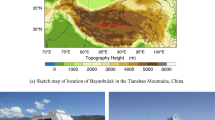Abstract
Weather radar is a traditional remote sensing tool for precipitation observation and analysis. Compared with millimeter wave radar, it is less affected by attenuation, but at the same time, it has lower spatial and temporal resolution normally. Cloud radar has shorter wavelength and can detect basic information of cloud, such as cloud height, thickness and other parameters. It provides a fantastic technique to study fine structure for clouds. But due to the attenuation effect it is rarely used to analyze precipitation. In this paper, A cloud radar and a C-band weather radar nearby are used to analyze two precipitation processes. The Z-I relationship can be obtained by combining ground automatic precipitation observation at the same site of the cloud radar. By a primitive research in this paper, the characteristics of stratiform precipitation was obtained by analyzing the reflectivity vertical profiles, layer mean reflectivity and standard deviation from cloud radar and C-band radar, and it shows that some useful information can be retrieved using cloud radar observation even under precipitation conditions. So with the higher spatial and temporal resolution, more research work will be focused on the fine vertical structure characteristics retrieval from cloud radar observation in the future.
Access this chapter
Tax calculation will be finalised at checkout
Purchases are for personal use only
Similar content being viewed by others
References
Tinel, C., Testud, J., Pelon, J.: The retrieval of ice-cloud properties from cloud radar and lidar synergy. J. Appl. Meteorol. 44(6), 860–875 (2005)
Cao, J.W., Liu, L.P., Chen, X.H., Chen, G.: Data quality analysis of 3836 C-band dual-linear polarimetric weather radar and its observation of a rainfall process. J. Appl. Meteorol. Sci. 17(2), 192–200 (2006)
Zhong, L.Z., Liu, L.P., Ge, R.S.: Characteristics about the millimeter wavelength radar and its status and prospect and abroad. Adv. Earth Sci. 24(4), 291–384 (2009)
Plana-Fattori, A., Protat, A., Delano, J.: Observation ice cloud with a doppler cloud radar. Comptesrendus Physique 11(1), 96–103 (2010)
Matrosov, S.Y.: Synergetic use of millimeter and centimeter wavelength radar for retrievals of cloud and rainfall parameters. Atmos. Chem. Phys. 10(7), 3321–3331 (2010)
Liu, L.P., Zong, R., Qi, Y.B., Liu, J.: Microphysical parameters retrieval by cloud radar and comparing with aircraft observation in stratiform cloud. Eng. Sci. 14(9), 64–71 (2012)
Boodoo, S., Hudak, D., Ryzhkov, A., Zhang, P.: Quantitative precipitation estimation from a C-Band dual-polarized radar for 8 July 2013 flood in Toronto, Canada. J. Hydrometeorol. 16(5) (2015)
Acknowledgments
This research is supported by Beijing Municipal Natural Science Foundation (Grant No. 8141002), Scientific Project of Chengdu University of Information Technology (Grant No. KYTZ201529) and National Key Basic Research Program of China (Grant No. 2014CB441401).
Author information
Authors and Affiliations
Corresponding author
Editor information
Editors and Affiliations
Rights and permissions
Copyright information
© 2019 Springer Nature Singapore Pte Ltd.
About this paper
Cite this paper
Lai, C., Su, D., Qi, Y. (2019). A Primitive Research on Precipitation Observation Parameters with 35 GHZ Cloud Radar. In: Liang, Q., Mu, J., Jia, M., Wang, W., Feng, X., Zhang, B. (eds) Communications, Signal Processing, and Systems. CSPS 2017. Lecture Notes in Electrical Engineering, vol 463. Springer, Singapore. https://doi.org/10.1007/978-981-10-6571-2_194
Download citation
DOI: https://doi.org/10.1007/978-981-10-6571-2_194
Published:
Publisher Name: Springer, Singapore
Print ISBN: 978-981-10-6570-5
Online ISBN: 978-981-10-6571-2
eBook Packages: EngineeringEngineering (R0)




